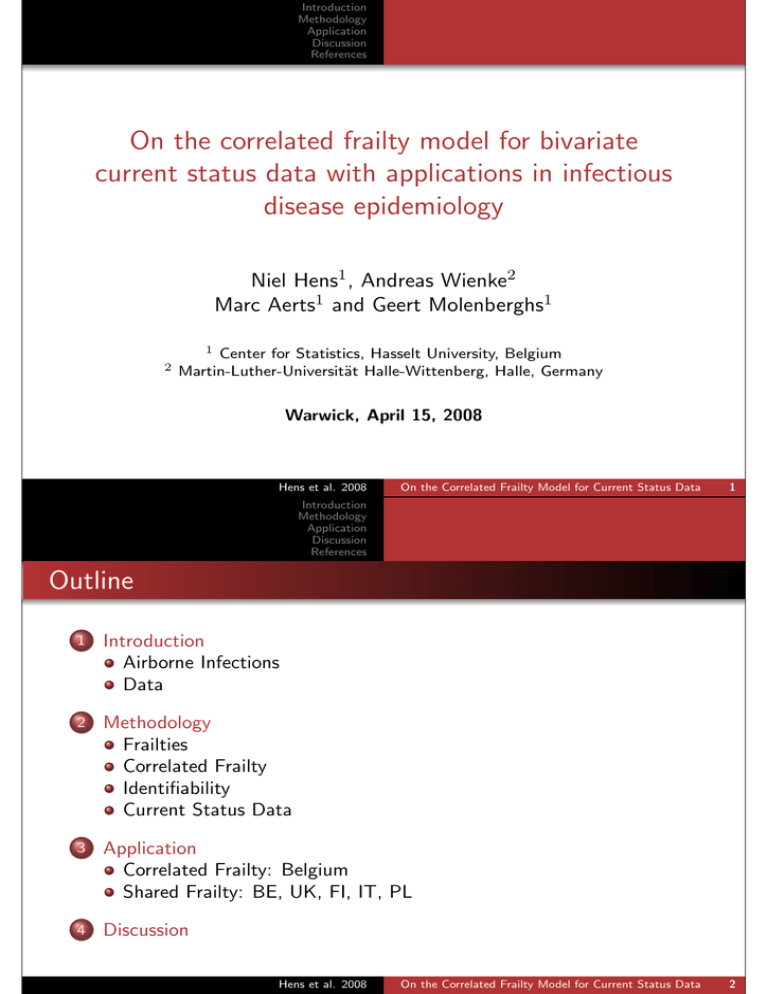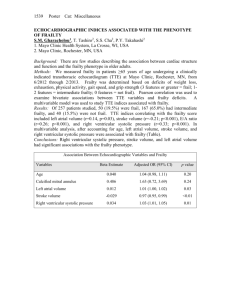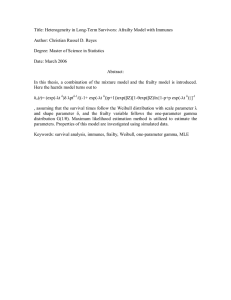On the correlated frailty model for bivariate disease epidemiology
advertisement

Introduction Methodology Application Discussion References On the correlated frailty model for bivariate current status data with applications in infectious disease epidemiology Niel Hens1 , Andreas Wienke2 Marc Aerts1 and Geert Molenberghs1 1 2 Center for Statistics, Hasselt University, Belgium Martin-Luther-Universität Halle-Wittenberg, Halle, Germany Warwick, April 15, 2008 Hens et al. 2008 On the Correlated Frailty Model for Current Status Data 1 Introduction Methodology Application Discussion References Outline 1 Introduction Airborne Infections Data 2 Methodology Frailties Correlated Frailty Identifiability Current Status Data 3 Application Correlated Frailty: Belgium Shared Frailty: BE, UK, FI, IT, PL 4 Discussion Hens et al. 2008 On the Correlated Frailty Model for Current Status Data 2 Introduction Methodology Application Discussion References Airborne Infections Data Airborne Infections Examples: measles, mumps, varicella, parvovirus B19, . . . Compartmental models: SIR, MSIR, MSEIR, . . . Basic reproduction number R0 R0 > 1 → epidemic R0 < 1 → eradication Infectious disease control - vaccination Critical Vaccination Coverage: 1 − 1/R0 Hens et al. 2008 Introduction Methodology Application Discussion References On the Correlated Frailty Model for Current Status Data 3 Airborne Infections Data Airborne Infections Crucial parameter: transmission rate: 1st, 2nd moment Surrogate: force of infection and the associated heterogeneity Problem: ‘current status’ data rather than ‘time to event’ data Solution? Estimating the force of infection from current status data: Muench (1934); Grenfell and Anderson (1985); Keiding (1991), . . . Estimating heterogeneity: Farrington et al. (2001); Sutton et al. (2006): shared frailty Hens et al. 2008 On the Correlated Frailty Model for Current Status Data 4 Introduction Methodology Application Discussion References Airborne Infections Data Estimating the FOI from Serological Data Varicella Zoster Virus and Parvovirus B19 As a proxy for other airborne infections No vaccination yet (Europe) Other diseases (CMV, EBV, ...) Data: Belgium, England & Wales, Finland, Italy and Poland Age-range: 0-20 years Hens et al. 2008 Introduction Methodology Application Discussion References On the Correlated Frailty Model for Current Status Data 5 Airborne Infections Data Varicella Zoster Virus (VZV) Varicella Primary VZV infection results in chickenpox Transmission: direct or aerosol contact When infected, infectious for about 7 days Incubation period of two weeks Reactivation later in life (10 − 20%): herpes zoster or shingles Disease burden: zoster: 25% is in constant pain Hens et al. 2008 On the Correlated Frailty Model for Current Status Data 6 Introduction Methodology Application Discussion References Airborne Infections Data Parvovirus B19 (B19) B19 B19 infection causes the so-called ‘fifth disease’, a mild rash illness (‘slapped-cheek’ rash) Transmission: respiratory droplets Infectious during the incubation period (± 14 days) Disease burden: for pregnant women there is a potential for the newborn to have severe anemia, possibly leading to miscarriage. Hens et al. 2008 On the Correlated Frailty Model for Current Status Data Introduction Methodology Application Discussion References 7 Airborne Infections Data Belgium, England & Wales, Finland, Italy, Poland 0 5 15 0 5 15 0.8 0.0 0.4 0.8 0.0 0.4 0.8 0.0 0 5 VZV (Poland) Seroprevalence VZV VZV (Italy) Seroprevalence VZV VZV (Finland) 0.4 Seroprevalence VZV 0.8 15 0 5 15 0 5 15 B19 (Finland) B19 (Italy) B19 (Poland) 15 0 5 0.4 0.0 0.4 0.0 0.0 0.4 0.8 0.0 0.4 0.8 0.4 0 5 0.8 B19 (England & Wales Seroprevalence B19 B19 (Belgium) 0.8 age Seroprevalence B19 age 0.8 age Seroprevalence B19 age Seroprevalence B19 age 0.0 Seroprevalence B19 0.4 0.0 0.4 0.8 Seroprevalence VZV VZV (England & Wales 0.0 Seroprevalence VZV VZV (Belgium) 15 0 5 Model 15 0 5 Data 15 Hens et al. 2008 0 5 On15the Correlated Frailty for Current Status 8 Introduction Methodology Application Discussion References Frailties Correlated Frailty Identifiability Current Status Data Frailties Coutinho et al. (1999) Persistent differences among individuals in their susceptibility, propensity, or relative risk with regard to the acquisition of infections. Individuals have different frailties The most frail individuals will experience the effect of the event earlier Vaupel et al. (1979); Aalen (1988): λ(a, ω) = ωλ(a, 1) with ω a nonnegative mixing variable Often E(ω) = 1 is chosen, e.g. ω ∼ Γ(θ, 1/θ) Hens et al. 2008 Introduction Methodology Application Discussion References On the Correlated Frailty Model for Current Status Data 9 Frailties Correlated Frailty Identifiability Current Status Data ω ∼ Γ(θ, 1/θ) 2.5 Gamma(a,b) 0.0 0.5 1.0 density 1.5 2.0 0.5 1 2 4 6 8 10 12 14 16 18 20 22 24 26 28 30 32 34 36 0 1 2 3 4 5 Relative Risk f (x) = 1 θ θ−1 −θx θ x e , Γ(θ) Hens et al. 2008 θ > 0, x > 0 On the Correlated Frailty Model for Current Status Data 10 Introduction Methodology Application Discussion References Frailties Correlated Frailty Identifiability Current Status Data Time to Infection Assume we have two infections with infection times Ti , i = 1, 2 Denote the CDF Fi (ti ) = P (Ti ≤ ti ) Denote the survival function; proportion susceptible Z ti Si (ti ) = exp − λi (u)du = exp(−Hi (ti )) 0 The infection hazard; force of infection λ(ti ) = − d fi (ti ) log(Si (ti )) = dti Si (ti ) Hens et al. 2008 Introduction Methodology Application Discussion References On the Correlated Frailty Model for Current Status Data 11 Frailties Correlated Frailty Identifiability Current Status Data Univariate Frailty Assume frailty distributions Zi , i = 1, 2 Conditional survival function for infection i with frailty Zi , i = 1, 2 Rt − 0 i λi (Zi ,u)du Si (ti |Zi ) = e Proportional hazards assumption λi (Zi , u) = Zi λi0 (u) − Si (ti |Zi ) = e R ti 0 Zi λi0 (u)du The unconditional survival function Z ti Si (ti ) = pi λi0 (u)du 0 with pi the Laplace transform of Zi , i = 1, 2, Hens et al. 2008 On the Correlated Frailty Model for Current Status Data 12 Introduction Methodology Application Discussion References Frailties Correlated Frailty Identifiability Current Status Data Correlated Frailty Assuming conditional independence T1 ⊥T2 |Z1 , Z2 S(t1 , t2 |Z1 , Z2 ) = S1 (t1 |Z1 ) × S2 (t2 |Z2 ) with (Z1 , Z2 ) following a bivariate frailty distribution Yashin et al. (1995): correlated gamma frailty: scale 1, variances σi2 , correlation ρ σ 1− σ1 ρ S(t1 , t2 ) = [S1 (t1 )] −σ12 ×[S1 Si (ti ) = (1 + 2 σ 1− σ2 ρ × [S2 (t2 )] −σ22 (t1 ) + S2 1 − σ ρσ (t2 ) − 1] 1 2 −1 2 σi2 H̃i (ti )) σi Hens et al. 2008 Introduction Methodology Application Discussion References On the Correlated Frailty Model for Current Status Data 13 Frailties Correlated Frailty Identifiability Current Status Data Identifiability 1 σi = 0: no frailty 2 σi = σ > 0; ρ = 0: univariate frailty → Elbers and Ridder (1982); Heckman (1984); Hougaard (1986) 3 σi = σ > 0; ρ = 1: shared frailty → Honoré (1993) 4 σ1 , σ2 > 0; 0 ≤ ρ ≤ 1: correlated frailty → Yashin et al. (1995) Estimation: ML, EM and MCMC Hens et al. 2008 On the Correlated Frailty Model for Current Status Data 14 Introduction Methodology Application Discussion References Frailties Correlated Frailty Identifiability Current Status Data Current Status Data Serological studies: current status data Sero-Negative: infected after the test Sero-Positive: infected before the test Age at infection Age at test Age at infection Age at test Age Age RIGHT CENSORED DATA LEFT CENSORED DATA Hens et al. 2008 Introduction Methodology Application Discussion References On the Correlated Frailty Model for Current Status Data 15 Frailties Correlated Frailty Identifiability Current Status Data Current Status Data Denote Yi the binary current status variable for infection i πi (a) = P (Yi = 1|a) = P (Ti ≤ a) Seroprevalence π̃i (a) = P (Ỹi ≤ a) Assume no diagnostic test uncertainty πi (a) = π̃i (a) The force of infection fi (a) πi0 (a) λi (a) = = Si (a) 1 − πi (a) Hens et al. 2008 On the Correlated Frailty Model for Current Status Data 16 Introduction Methodology Application Discussion References Frailties Correlated Frailty Identifiability Current Status Data Current Status Data The correlated frailty expression now becomes σ 1− σ1 ρ S(a, a) = [S1 (a)] 2 −σ12 ×[S1 (a) σ 1− σ2 ρ × [S2 (a)] + −σ22 S2 (a) 1 − σ ρσ − 1] 1 2 The correlated frailty simplifies to: Extended shared frailty ρ = 1 σ1 σ2 −σ12 S(a, a) = [S1 (a)]1− σ2 ×[S2 (a)]1− σ1 ×[S1 −σ22 (a)+S2 1 (a)−1]− σ1 σ2 Shared frailty ρ = 1, σ1 = σ2 = σ 2 2 1 S(a, a) = [S1−σ (a) + S2−σ (a) − 1]− σ2 → Farrington et al. (2001); Sutton et al. (2006) Hens et al. 2008 Introduction Methodology Application Discussion References On the Correlated Frailty Model for Current Status Data 17 Frailties Correlated Frailty Identifiability Current Status Data Current Status Data Note that Si (a) = 1 + σi2 Z 0 a λi0 (u)du −1/σi2 where λi0 (u) is the baseline force of infection. Alternatively Z Si (a) = exp − 0 a λi (u)du where λi (u) is the force of infection. Hens et al. 2008 On the Correlated Frailty Model for Current Status Data 18 Introduction Methodology Application Discussion References Correlated Frailty: Belgium Shared Frailty: BE, UK, FI, IT, PL Analysis Piecewise constant FOI: [0, 3), [3, 6), [6, 12)[12, 20) : λij Gamma frailties 4 models: NF: univariate model without frailty SF: bivariate model shared frailty, correlation one ESF: bivariate model extended shared frailty, correlation one CF: bivariate model correlated frailty SAS NLMIXED, MLa Hens et al. 2008 Introduction Methodology Application Discussion References On the Correlated Frailty Model for Current Status Data 19 Correlated Frailty: Belgium Shared Frailty: BE, UK, FI, IT, PL Results: Belgium par λ̃11 λ̃12 λ̃13 λ̃14 λ̃21 λ̃22 λ̃23 λ̃24 σ1 σ2 ρ -2loglik NF estimate (se) 0.060 (0.012) 0.124 (0.026) 0.087 (0.019) 0.072 (0.020) 0.264 (0.029) 0.450 (0.073) 0.179 (0.044) 0 (-) SF estimate (se) 0.060 (0.012) 0.125 (0.026) 0.085 (0.019) 0.072 (0.020) 0.265 (0.029) 0.455 (0.073) 0.173 (0.044) 0 (-) 0.401 (0.082) 0.401 (0.082) ESF estimate (se) 0.060 (0.012) 0.125 (0.026) 0.085 (0.019) 0.072 (0.020) 0.262 (0.029) 0.453 (0.073) 0.179 (0.043) 0 (-) 2.178 (24.467) 6.165 (69.339) 2823.9 2816.2 2810.0 CF estimate se 0.060 (0.012) 0.125 (0.026) 0.085 (0.019) 0.072 (0.020) 0.262 (0.029) 0.453 (0.073) 0.179 (0.043) 0 (-) 1.734 (5.040) 4.877 (14.089) 1 (-) 2810.0 Note: ‘rhobit’-link function was used to estimate ρ Hens et al. 2008 On the Correlated Frailty Model for Current Status Data 20 Introduction Methodology Application Discussion References Correlated Frailty: Belgium Shared Frailty: BE, UK, FI, IT, PL Result Unidentifiability of the correlated gamma frailty for current status data ‘rhobit’-link univariate monitoring times Is the extended shared frailty identifiable? σ1 σ̂2 2 0.27(0.07) 4 0.45(0.11) 6 0.65(0.16) 8 0.85(0.21) 10 1.06(0.26) Hougaard (2000): “having two random effects for the same source of variation implies that it will be difficult or impossible to separate the random effects” Hens et al. 2008 Introduction Methodology Application Discussion References On the Correlated Frailty Model for Current Status Data 21 Correlated Frailty: Belgium Shared Frailty: BE, UK, FI, IT, PL Shared Frailty: BE, UK, FI, IT, PL We take the FOI as piecewise constant over different age-categories Enrolment ages (Source OECD, statistics on education): Enrolment level Pre-school Pre-primary Primary Secondary and tertiary BE [0,3[ [3,6[ [6,12[ 12+ Country EW FI [0,3[ [0,3[ [3,5[ [3,7[ [5,11[ [7,13[ 11+ 13+ IT [0,3[ [3,6[ [6,11[ 11+ PL [0,3[ [3,7[ [7,13[ 13+ Selecting the most parsimonious model using BIC Hens et al. 2008 On the Correlated Frailty Model for Current Status Data 22 Introduction Methodology Application Discussion References Correlated Frailty: Belgium Shared Frailty: BE, UK, FI, IT, PL Shared Frailty: BE, UK, FI, IT, PL Source FOI B19 FOI VZV Heterogeneity Parameter Infants Pre-primary Primary Secondary Infants Pre-primary Primary Secondary Shape Belgium 0.068 0.110 0.092 0.069 0.287 0.356 0.222 0 8.283 Hens et al. 2008 Introduction Methodology Application Discussion References E&W 0.068 0.032 0.092 0.017 0.148 0.167 0.222 0 1.984 Finland 0.013 0.032 0.092 0.017 0.090 0.356 0.222 0 8.283 Italy 0.068 0.032 0.092 0.017 0.148 0.167 0.222 0 8.283 Poland 0.068 0.032 0.092 0.017 0.148 0.167 0.222 0 1.984 On the Correlated Frailty Model for Current Status Data 23 Correlated Frailty: Belgium Shared Frailty: BE, UK, FI, IT, PL Sensitivity Analysis Changing the functional relationship: B-splines, parametric modelling Changing the frailty distribution: log-normal, log-mixture of normals Using different copulas: Clayton’s copula, Gumbel, . . . Hens et al. 2008 On the Correlated Frailty Model for Current Status Data 24 Introduction Methodology Application Discussion References Discussion Time to event - current status Survival setting - generalized linear mixed models Inevitable loss of information Unidentifiability of the correlated frailty Apparent (un)identifiability of the shared frailty Further research Simulation study: what do we loose? Singular information matrix? Rotnitzky et al. (2000) Hens et al. 2008 On the Correlated Frailty Model for Current Status Data 25 Introduction Methodology Application Discussion References References Aalen, O. (1988). Heterogeneity in survival analysis. Statistics in Medicine, 7:1121–1137. Coutinho, F., Massad, E., Lopez, L., Burattini, M., Struchiner, C., and Azevedo-Neto, R. (1999). Modelling heterogeneities in individual frailties in epidemic models. Mathematial and Computer Modelling, 30:97–115. Elbers, C. and Ridder, G. (1982). True and spurious duration dependence: The identifiability of the proportional hazard model. Review of Economic Studies, 49:403–409. Farrington, C., Kanaan, M., and Gay, N. (2001). Estimation of the basic reproduction number for infectious diseases from age-stratified serological survey data. Applied Statistics, 50:251–292. Grenfell, B. T. and Anderson, R. M. (1985). The estimation of age-related rates of infection from case notifications and serological data. Journal of Hygiene, 95(2):419–36. Heckman, J. ans Singer, B. (1984). The identifiability of the proportional hazard model. Review of Economic Studies, 51(2):231–241. Honoré, B. (1993). Identification results for duration models with multiple spells. Review of Economic Studies, 60:241–246. Hougaard, P. (1986). Survival models for heterogeneous populations derived from stable distributions. Biometrika, 73:387–396. Hougaard, P. (2000). Analysis of multivariate survival data. New York: Springer. Keiding, N. (1991). Age-specific incidence and prevalence: A statistical perspective (with discussion). JRSS-A, 154:371–412. Muench, H. (1934). Derivation of rates from summation data by the catalytic curve , vol. 29, no. 185 (mar., 1934), pp. 25-38. Journal of the American Statistical Association, 29:25–38. Rotnitzky, A., Cox, D., Bottai, M., and Robins, J. (2000). Likelihood-based inference with singular information matrix. Bernoulli, 6(2):243–284. Sutton, A., Gay, N., Edmunds, W., Hope, V., Gill, O., and Hickman, M. (2006). Modelling the force of infection for hepatitis b and hepatitis c in injecting drug users in England and Wales. BMC Infectious Diseases, 6:93. Vaupel, J., Manton, K., and Stallard, E. (1979). The impact of heterogeneity in individual frailty in the dynamics of mortality. Demography, 16(3):439–454. Yashin, A., Vaupel, J., and Iachine, I. (1995). Correlated individual frailty: An advantageous approach to survival analysis of bivariate data. Mathematical Population Studies, 5:145–159. Hens et al. 2008 On the Correlated Frailty Model for Current Status Data 26







